Stage 5 – Serravalle Pistoiese / Pistoia
From Serravalle Pistoiese to Pistoia – km 11,0
One last excursion in the hills that divide Serravalle Pistoiese and Pistoia, among woods, rows of cypresses, ancient villas; up to the convent of Giaccherino from which, as from the Monte do Gozo that precedes Santiago, we descend to reach the Cathedral and thus conclude our pilgrimage at the relics of St. James
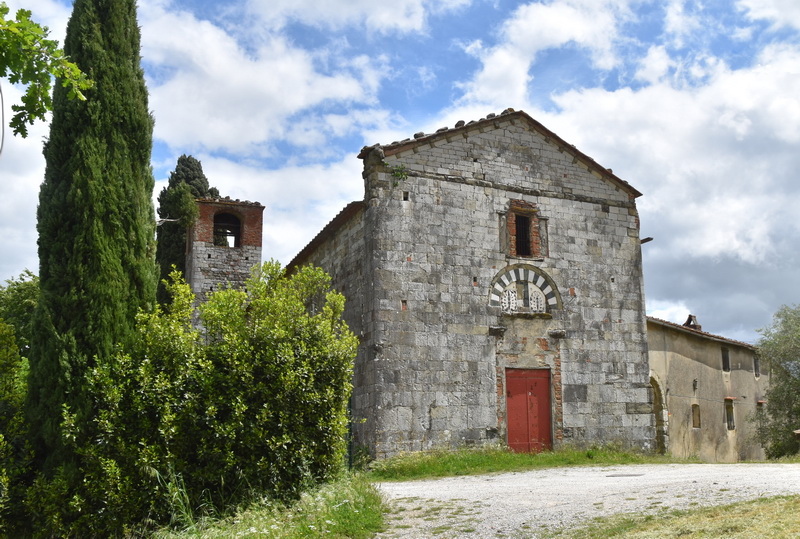
We walk along Serravalle in all its length exiting from Via Garibaldi. From a belvedere with two trees we can see, beyond the hills, the city of Pistoia. We go to the left, down via Romana until reaching the busy provincial road 435. From here descend left on a small road, reaching the bottom of the valley. Arriving at a group of recently built houses, we need to locate a gate placed at the end of a fence: we open it and cross the lawn to reach via Castellina, a small road on the other side. Arriving at number 8 (with a sign for a bus stop), we have to go up to the right into an open space [it looks like a private property, but we can enter!]; we continue on a small road that climbs into the woods. Before reaching the top we have to turn right onto a dirt road that proceeds flat and then descends to the bottom of a small valley. We take the road to the left and we arrive at a kindergarten; we continue, crossing a green area that ends on the SR435. We follow this to the left for 150 meters, then we enter on our left, the built-up area of Stazione Masotti (km 2.6).
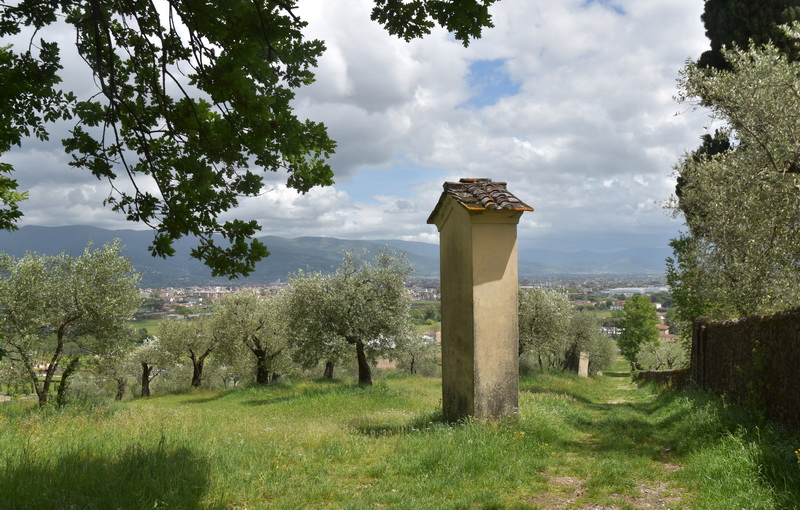
We walk along via Composition, then via Dori and, shortly after, we turn right and climb the stairs to via Leonardo da Vinci, which we follow to the left until the end of a wide curve to the right. At this point we leave the road and the village of Stazione Masotti: we go up to the left along a dirt road that goes into the woods and takes us to a hill; after a stretch on a slight slope we begin to descend reaching the bottom of a beautiful valley; we entered the territory of the Groppoli agro-wildlife farm.
We cover the valley road with a row of cypresses running along the side and we climb gently until we reach the villa of Groppoli (km 4.6). Pasing behind, we go down to the right on a small road that reaches the bottom of a canal at the height of a big abandoned house. We continue climbing, sometimes in woods, with beautiful views over the villa of Groppoli, until we reach the top of the hill. We turn right on a small road that leads us to a hamlet with the ancient Pieve di San Michele in the center (km 5.6). It is a very suggestive place, on the top of the hill: from here are views of the valleys that descend from the Pistoia Apennines.
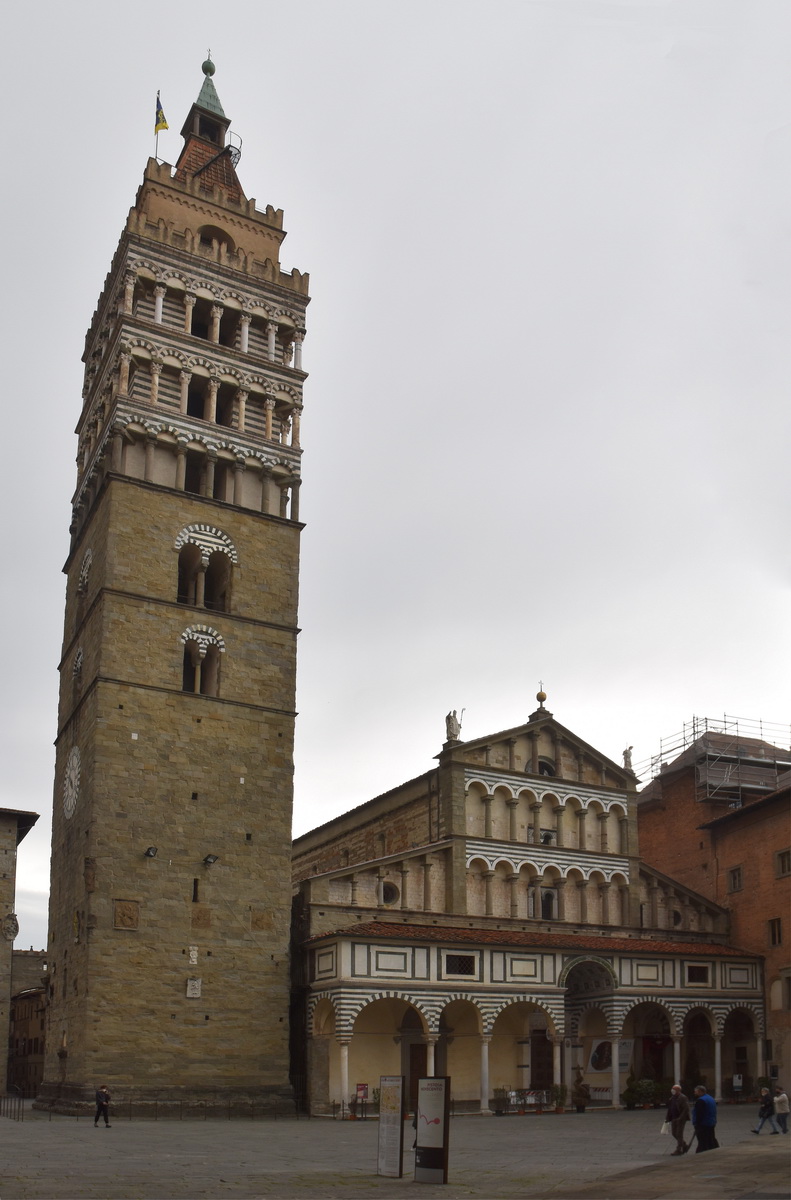
We take a small road with an uneven surface, that descends rapidly, at times even with a steep gradient, to the historic villa of Agnolaccio. Rising a little to the next crossroads we turn left and reach the “A Casa nostra” farmhouse, which has a snack bar.. We descend a slightly and then go up again to reach the convent of Giaccherino (km 7,3).
Here begins a Via Crucis, that winds along the ancient paved road that reaches the village of Pontelungo, the extreme outskirts of Pistoia. We descend on the pavement, now rather bumpy, with very wide views of the city, the plain of Pistoia and the Apennines. We go out on the road that runs along the Ombrone embankment, which we follow until we reach the provincial road Lucchese which, with a perfectly straight path of 2.5 km, reaches the center of Pistoia. It is not a nice walk, especially the approach to the historic center, where we enter over the Porta Lucchese roundabout, a large intersection of roads. We take Via Sacconi, continue on via Puccini, then via Madonna, then via Orafi and finally we arrive at the entrance to Piazza del Duomo, the center of Pistoia (km 11.0). On the corner, to our right, there is the signpost (mojòn) given by the Xunta de Galicia to celebrate the Jacobean link between the city and Santiago de Compostela.
We cross the square and enter the Cathedral to conclude our pilgrimage to the relics of St. James in meditation.
One last flight between the hills that divide Serravalle Pistoiese from Pistoia, among woods, rows of cypresses, ancient villas, up to the convent of Giaccherino from which, as from the Monte do Gozo that precedes Santiago, we descend to reach the Cathedral and thus conclude our pilgrimage to the relics of St. James.
services
PISTOIA
Hospitality Sant’Andrea (active from15 giugno 2021) – Via Sant’Andrea, rectory of the homonymous church. tel. 353.4272320. 12 seats, kitchen, bathrooms and showers, living area, garden, responsible donation
Foresteria San Domenico (0.5 km from the Duomo) Via delle Logge, 4 – tel. 331 6857773 Inside the convent of San Domenico and a stone’s throw from Piazza Garibaldi and the historic center, the guesthouse can accommodate up to 25 people in rooms with two or more beds, with common spaces and use of the kitchen, located in a recently renovated environment respecting the convent style.
Serravalle Pistoiese
Serravalle P. is served by the Stazione Masotti – Trenitalia – Pistoia – Lucca – Pisa line
Blubus Copit Pistoia – line 53 and line 63 for Pontelungo, Pistoia and in the opposite direction for
Pistoia
Trenitalia – Pistoia – Lucca – Pisa line and line for Florence
Blubus Copit Pistoia – line 53 and line 63 for Pontelungo, Serravalle Pistoiese, Monsummano T.
Taxi – parking on the square in front of the train station
Pharmacies: Serravalle P., Pistoia
Hospital: Pistoia
Bar: Serravalle P., Pistoia
Restaurants: Serravalle P., Pistoia
Bank: Serravalle P. (Masotti Station), Pistoia
Post Office: Serravalle P., Pistoia
Railway Station: Serravalle P., Pistoia
Sports equipment: Pistoia
Food and Supermarket: Serravalle P., Pistoia
Mechanical assistance service for bicycles: Pistoia
For the stretch from Serravalle Pistoiese to Pistoia you can call:
– Lodovica 328.4688200
– Paolo 348.3326624
places
It meets before the bridge that crosses the Ombrone Pistoiese, of Roman origin as evidenced by the foundations of the two stone and brick piles. The village is dominated by the Giaccherino hill on whose summit the large complex of the Renaissance convent of the same name still stands, which was one of the main Franciscan seminaries in central Italy.
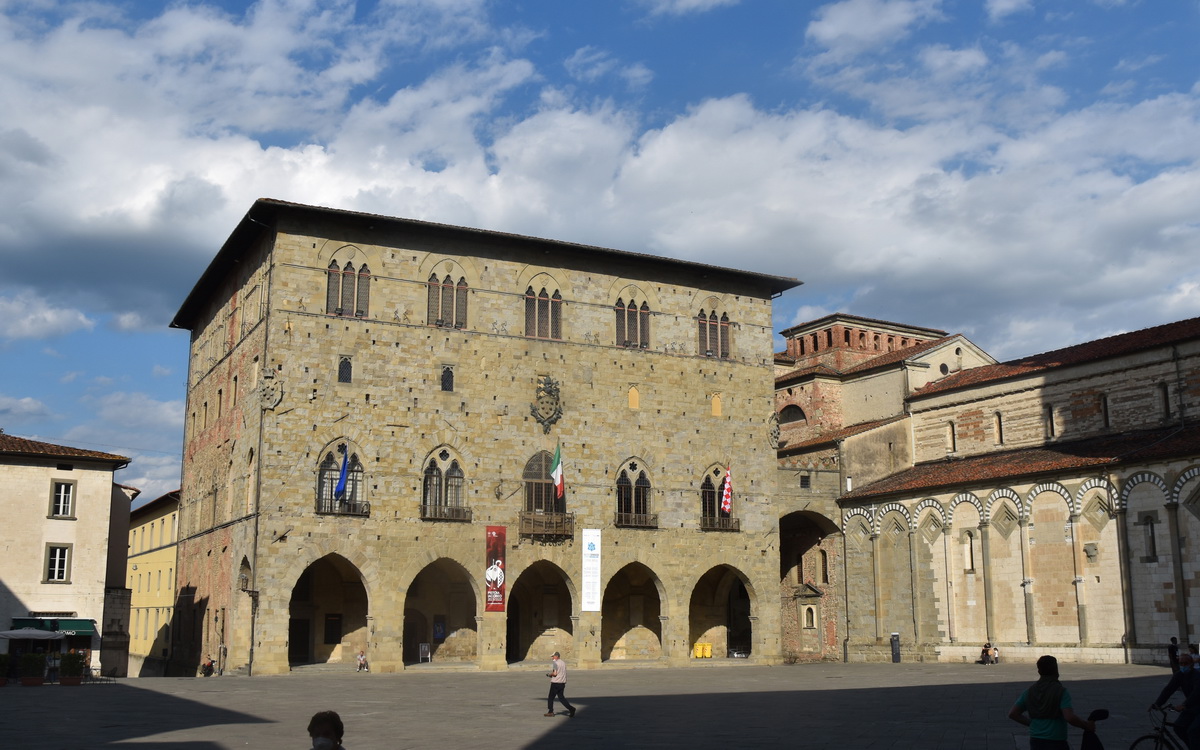
How beautiful it is to walk around this ancient city. Rightly called the “city of enchanted stone”, it presents a succession of churches, cloisters, palaces, museums and monuments located around one of the most fascinating Piazza del Duomo in Italy. Here are the Palazzo Comunale, the Palazzo Pretorio, the Cathedral of San Zeno, the Palazzo dei Vescovi, the Baptistery and the spectacular bell tower. The historic core is collected within three walls. Among the various religious monuments are the parish church of Sant’Andrea with the splendid pulpit by Giovanni Pisano. Piazza della Sala, “La Sala”, as the Pistoians call it, hosts the city market and some “historic” shops as well as wine bars, bars and restaurants. Pistoia is the capital of horticulture; it is possible to visit some nurseries and it is advisable to do so, you will discover a world and an Italian entrepreneurial excellence https://www.giorgiotesigroup.it/it/accogliere/
along the way
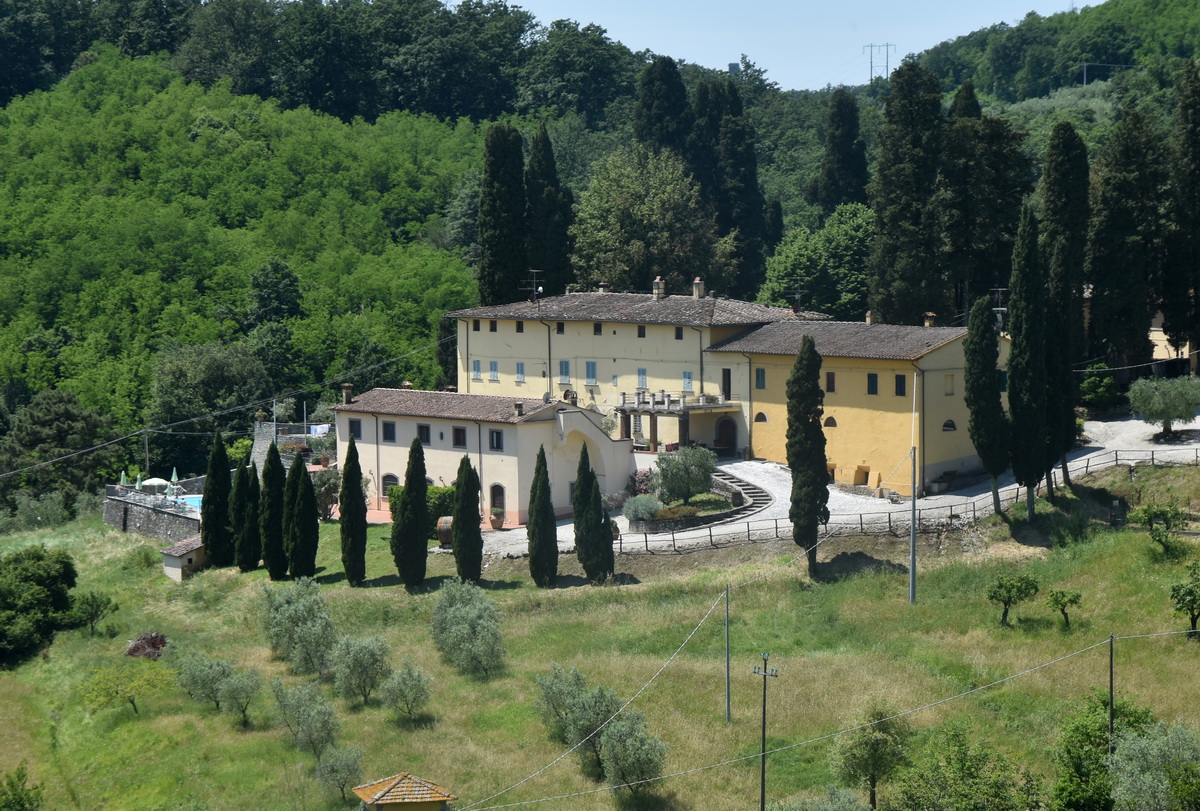 The beautiful estate of Groppoli welcomes us after a climb and invites us to a stop to admire the vast landscape and the tranquility of the farmland, adorned with lemon trees, laden with beautiful yellow fruits. It is a vast complex consisting of a farm, an ancient villa and several farmhouses. Today, the main activity tourism; mainly hospitality, but also artistic and cultural activities. A coveted place by young couples for the celebration of lavish weddings. The surrounding area is classified as a hunting reserve; those who pass through it in the early hours of the day may have a fleeting encounter with some of the wild animals that live there: wild boars, roe deer, fallow deer, mouflons, hares and pheasants.
The beautiful estate of Groppoli welcomes us after a climb and invites us to a stop to admire the vast landscape and the tranquility of the farmland, adorned with lemon trees, laden with beautiful yellow fruits. It is a vast complex consisting of a farm, an ancient villa and several farmhouses. Today, the main activity tourism; mainly hospitality, but also artistic and cultural activities. A coveted place by young couples for the celebration of lavish weddings. The surrounding area is classified as a hunting reserve; those who pass through it in the early hours of the day may have a fleeting encounter with some of the wild animals that live there: wild boars, roe deer, fallow deer, mouflons, hares and pheasants.
This “ugly archangel” (Psalms), called Agnolaccio, will give its name to the steep road that leads to the church, but for some it seems to refer to the ugly features of the statue depicting St. Michael the Archangel contained within this ancient Romanesque building that meets not far from the villa of Groppoli.
In 1474 it was assigned to the congregation of the Humiliati, one of the many spiritual movements that arose in contrast to the relaxed customs and widespread wealth often flaunted by the clergy, advocating a return to a more austere, frugal life. Initially condemned as heretics, they were reinstated with a decreet of Innocent III. The order was then suppressed in 1571.
Unfortunately, the church is inaccessible and it is therefore not possible to observe the interior where a pulpit dated 1193 is preserved, the aforementioned statue depicting St. Michael the Archangel and a beautiful stone baptismal font. Another nice place to stop for a short meditation or prayer.
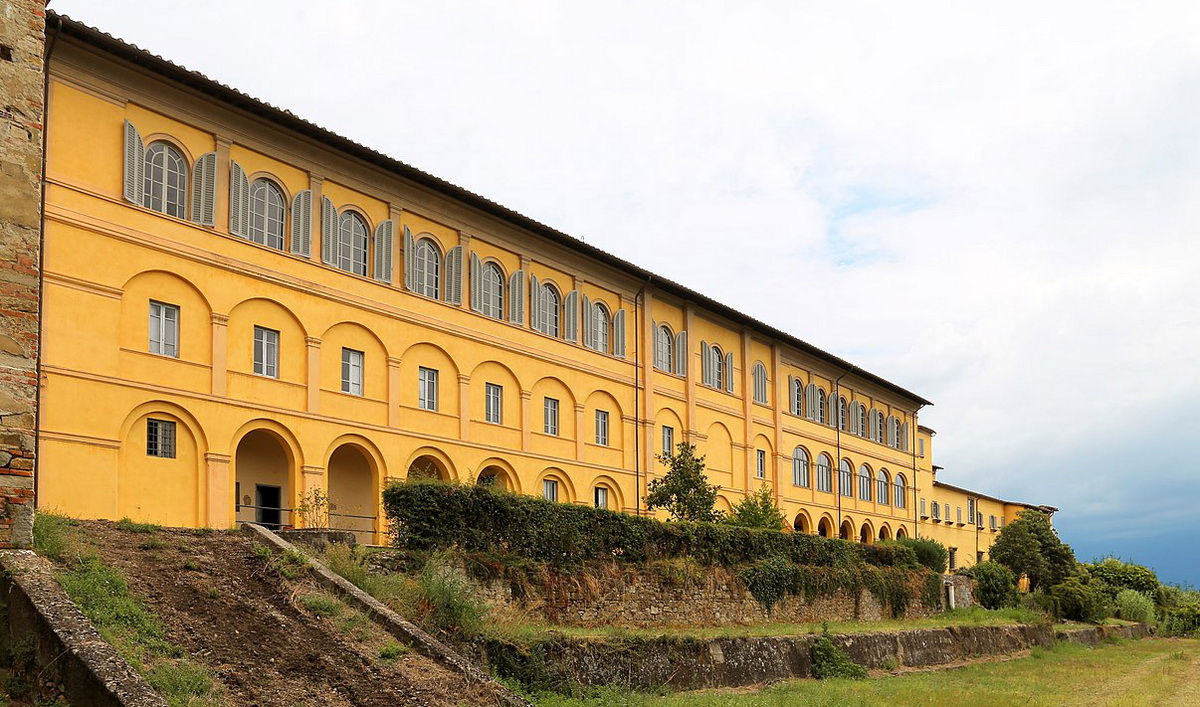
The foundation of this large convent and the beautiful church of San Francesco was inspired by the guilt of the Pistoian nobleman Gabriello Panciatichi, who thus wanted to atone for the sins of usury committed during his activity as a banker.
The convent, originally called “del Monte Lucense” (the mountain that separates it from Lucca), then took the name by which it is perhaps known by an innkeeper, such as Cecchino or Ceccherino, who kept an inn at the entrance to the steep road that reaches. However, we like more the version according to which the name originates from the term “Jacquaires” a word still in use in France to identify the pilgrims of St. James. These, almost at the end of their pilgrimage, arriving at the convent from the distant villages of the transalpine country, could finally see the city of Pistoia for the first time, the final destination of their devotional journey.
The complex originally included a small church, two cloisters (one for the friars and one for the novices), cells, a refectory, a kitchen and an infirmary. It was then enlarged and decorated, making it one of the most significant Franciscan complexes in Tuscany.
Since 2005 the convent has been sold to the Rinascimento Society of Pistoia, which has restored it and used it as a location for events and ceremonies. To visit the convent it is necessary to contact the company with full notice: Tel. 0573 911229 email info@conventodigiaccherino.it
A long Via Crucis descends from the convent towards Pistoia through the vast and ancient olive grove (via Scala di Giaccherino).
For more information: https://it.wikipedia.org/wiki/Convento_di_Giaccherino
In various parts of Italy it is still customary to say “my knees make me giacomo giacomo”. What is the origin of the sentence? Is it perhaps related to the Camino de Santiago? On the forum of the Accademia della Crusca website, Luigi Pizzilli published a message in which he examines and expresses his opinion on the issue, citing the interpretations of distinguished scholars. Taking a cue from other sources as well, I summarize the various hypotheses made.
- During the Hundred Years War, in 1358, a revolt broke out in France, in the Oise region, of peasants exasperated by the burden of taxes and the continuous looting to which they were subjected. The revolt quickly spread to Normandy, Picardy and Ponthieu but lasted just two weeks: the peasants were defeated and severely punished in the battle of Clermont by the forces led by Charles II of Navarre, known as “the Evil One”. In the clashes against the militias of the aristocrats, the peasants wore the jacque or jaco (jacket in cloth or wool strengthened by iron wires). Hence the French peasant was called with contempt “jacques bonhomme” and this revolt, like other subsequent peasant revolts, was called “jacquerie“. So the word, which initially indicated the dress, passed to refer generically to the farmer with the derogatory meaning of “simpleton”, “coward”. The expression “giacomo-giacomo” would indicate the knees of the peasant who were trembling in fear in the face of the army of landowners, equipped with more robust and resistant weapons than simple “jacques”. From this word derives the Italian “jacket”
- Another interpretation believes that the term derives in an onomatopoeic way from the creaking of the joints of the knees or from the dragging of the feet (ciac ciac, gia gia …)
- But there are also interpretations that link the phrase to the Camino de Santiago, albeit with different accents:
– as a pilgrim’s plea for St. James, to help him overcome his tiredness
– as a reminder of the tiredness of the pilgrims who arrived in Santiago exhausted and with shaky legs
– finally, a final interpretation is based on the popular belief that St. James took charge of taking the soul of the dying man and carrying it to heaven along the Milky Way road, called for this “road of San Giacomo”
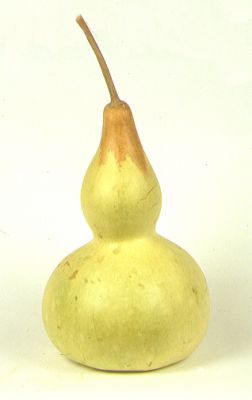 THE PUMPKIN OF THE PILGRIM
THE PUMPKIN OF THE PILGRIM
It belongs to the Cucurbitaceae family, Lagenaria genus, Lagenaria siceraria (or vulgaris) species. From the Latin lagena = bottle. Generally known in Italy as “fishermen’s gourd” or “pilgrim’s gourd” In French calebasse de pelerìn, in Spanish calabaza, in English bottle. Depending on the conformation of the fruit, the vulgaris, clavata, depressa, maxima varieties are distinguished.
Probably native to India, its cultivation has gradually spread to warm / humid areas throughout the planet.
Over time and in the various localities, Lagenaria has taken on a notable diversification both in shape, size and color. In Italy it was mainly cultivated in wetlands. It is now considered an endangered plant.
Everywhere it is traditionally cultivated and used to make containers for liquids or other loose materials, dishes, crockery. Once ripe, the pumpkin is left to dry. The upper end is cut and the seeds and residual parts are emptied. The container obtained is very light but at the same time very resistant to shocks and absolutely watertight. In Italy, fishermen stored fish and frogs there which, due to its particular shape, could not get out. Pilgrims used it as a container for water, thanks to its lightness and strength. Moreover, thanks to the particular shape, it could be comfortably carried over the shoulder or tied to the hips.
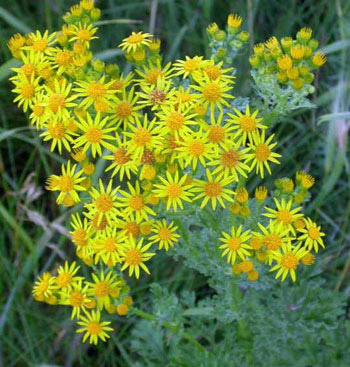
THE GRASS GIACOMA
It is the senecio jacobaea, also called St. James’s wort or St. James’s senecione, it is a poisonous herb widespread throughout Italy. It grows in uncultivated land, along the roadsides. It has deep yellow flowers. We have not been able to find out why it was called jacobaea, what relationship there is with St. James. Who has more information let us know.
